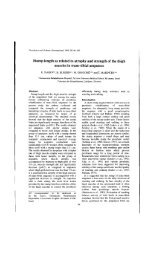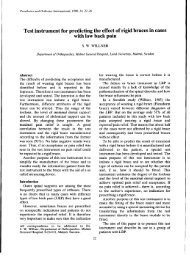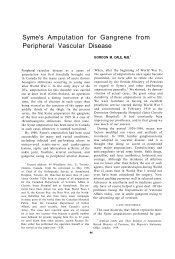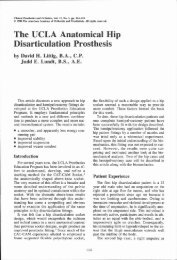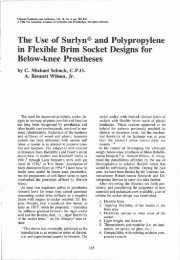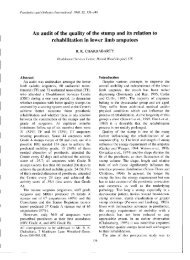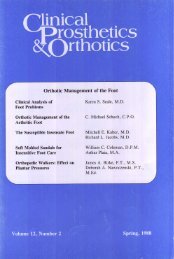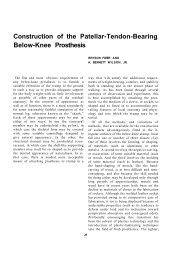The Biomechanics of Control in Upper-Extremity Prostheses
The Biomechanics of Control in Upper-Extremity Prostheses
The Biomechanics of Control in Upper-Extremity Prostheses
You also want an ePaper? Increase the reach of your titles
YUMPU automatically turns print PDFs into web optimized ePapers that Google loves.
BIOMECHANICS OF CONTROL 13<br />
theory have dealt largely with the frequent<br />
and <strong>in</strong>cautious extension <strong>of</strong> the concept. It is<br />
now believed that genetic and growth factors<br />
determ<strong>in</strong>e the essential form and dimensions <strong>of</strong><br />
bone. Mechanical stresses serve secondarily<br />
to mold and modify it to give added strength<br />
where stresses are greatest. One must grant<br />
from even a superficial exam<strong>in</strong>ation <strong>of</strong> the<br />
<strong>in</strong>ternal structure <strong>of</strong> bone that Nature has<br />
done an admirable job <strong>of</strong> design<strong>in</strong>g for maximum<br />
strength with m<strong>in</strong>imum weight.<br />
Fig. 10. Typical change <strong>in</strong> jo<strong>in</strong>t spaces with flexionextension,<br />
as revealed by the elbow. Redrawn from<br />
Ste<strong>in</strong>dler (17), after Fick. A, Gap <strong>of</strong> the medial border<br />
<strong>of</strong> the olecranon surface with elbow <strong>in</strong> extreme extension.<br />
B, Gap <strong>of</strong> the lateral border <strong>of</strong> the olecranon <strong>in</strong><br />
extreme flexion.<br />
portant mechanism for the performance <strong>of</strong><br />
gross work, such as lift<strong>in</strong>g, sl<strong>in</strong>g<strong>in</strong>g, and<br />
thrust<strong>in</strong>g. <strong>The</strong> arm bones serve further<br />
as positioners <strong>of</strong> the hand, <strong>in</strong> which other,<br />
f<strong>in</strong>er bones constitute the <strong>in</strong>tricate articulated<br />
framework <strong>of</strong> the manipulative mechanism.<br />
Two ma<strong>in</strong> features <strong>of</strong> bones merit discussion<br />
here—their <strong>in</strong>ternal composition and construction<br />
and their external shape and adaptations<br />
that permit them to serve as members<br />
<strong>of</strong> mechanical systems.<br />
Internal<br />
Structure<br />
<strong>The</strong>re is much evidence that the gross <strong>in</strong>ternal<br />
structure <strong>of</strong> bone is em<strong>in</strong>ently suited to<br />
withstand the mechanical stresses placed upon<br />
it by the compressive loads <strong>of</strong> weight-bear<strong>in</strong>g,<br />
by the tensions <strong>of</strong> tendons and ligaments, and<br />
by the lateral pressures <strong>of</strong> adjacent tissues (4).<br />
<strong>The</strong> nature and orientation <strong>of</strong> the trabeculae<br />
<strong>in</strong> cancellous bone have, for example, long been<br />
held, <strong>in</strong> theory, to provide the maximum<br />
strength along the l<strong>in</strong>es <strong>of</strong> major stresses. This<br />
idea, orig<strong>in</strong>ally suggested by von Meyer,<br />
has been championed by many, <strong>in</strong>clud<strong>in</strong>g<br />
Koch, who carried out a stress analysis on the<br />
femur (12). Objections to the von Meyer<br />
Members <strong>of</strong> Mechanical Systems<br />
<strong>The</strong> second pr<strong>in</strong>cipal feature <strong>of</strong> bones, that<br />
<strong>of</strong> serv<strong>in</strong>g as rigid members <strong>in</strong> a complex <strong>of</strong><br />
mechanical systems, is the one that has engaged<br />
the most attention. It is surpris<strong>in</strong>g that<br />
the simple lever concepts <strong>of</strong> Archimedes have<br />
persisted <strong>in</strong> anatomy and k<strong>in</strong>esiology texts to<br />
the present day. Thus, the forearm-flexor<br />
system is said to act as a third-class lever, the<br />
extensor system as a first-class lever. Although<br />
these assertions are <strong>of</strong> course true, both <strong>of</strong><br />
these systems are, <strong>in</strong> the more complete<br />
language <strong>of</strong> Newtonian mechanics, parts <strong>of</strong><br />
force-couple systems <strong>in</strong> which equal and<br />
opposite components <strong>of</strong> force are transmitted<br />
through the bones and jo<strong>in</strong>ts (Fig. 11). Elftman<br />
(7) has emphasized this view. <strong>The</strong><br />
magnitude <strong>of</strong> the couple is given by the product<br />
<strong>of</strong> the force (either <strong>of</strong> the equal but opposite<br />
forces) and the distance between them, which<br />
also is numerically equal to the torque <strong>of</strong> the<br />
muscle force. <strong>The</strong> concept <strong>of</strong> the couple calls<br />
attention to the existence <strong>of</strong> the equal and<br />
opposite forces <strong>in</strong> jo<strong>in</strong>ts and emphasizes the<br />
loads placed upon them by muscular work.<br />
Another and more complicated application<br />
<strong>of</strong> the couple is seen <strong>in</strong> scapular rotation.<br />
Here, as described by Inman el al. (11) and as<br />
shown <strong>in</strong> Figure 12,<br />
the pull <strong>of</strong> the lower<br />
fibers <strong>of</strong> the serratus anterior<br />
upon the scapula<br />
is such as to give it<br />
Fig. 11. Force couples at<br />
the elbow. Tensile forces<br />
<strong>in</strong> biceps and brahialis are<br />
associated with equal, opposite,<br />
and parallel forces<br />
through the jo<strong>in</strong>t.



